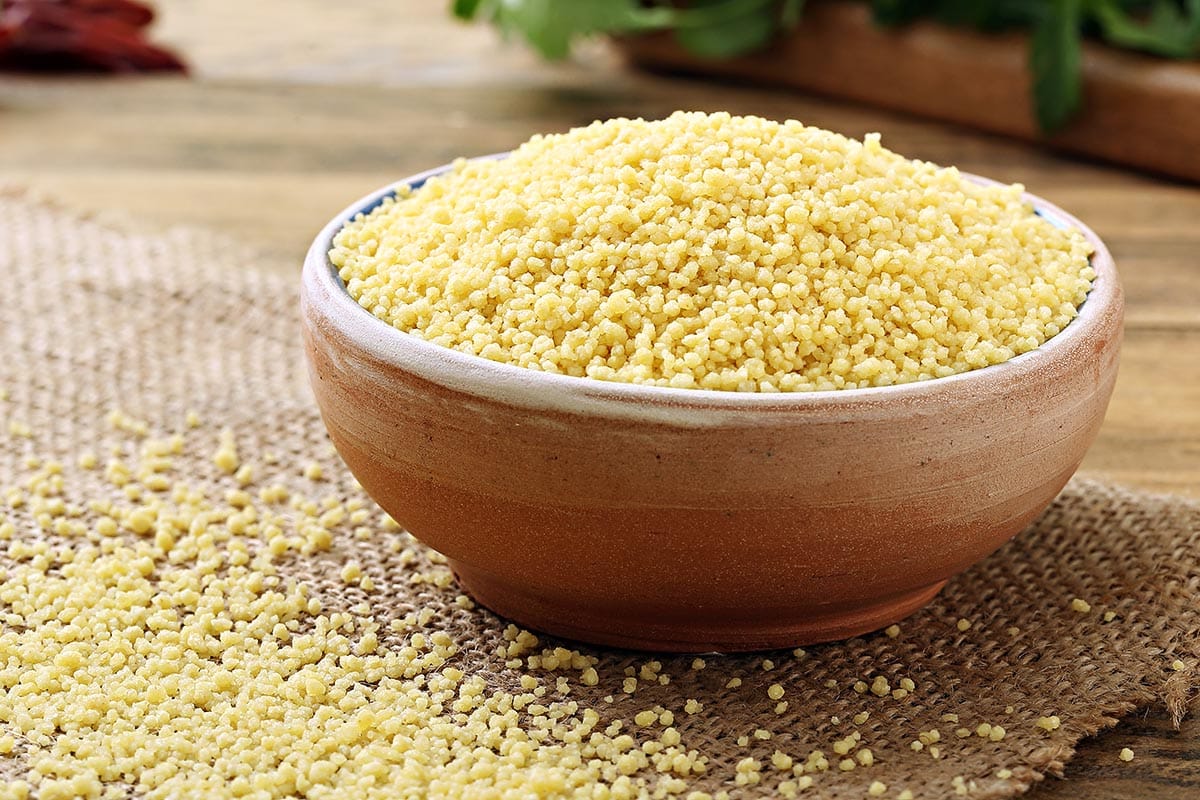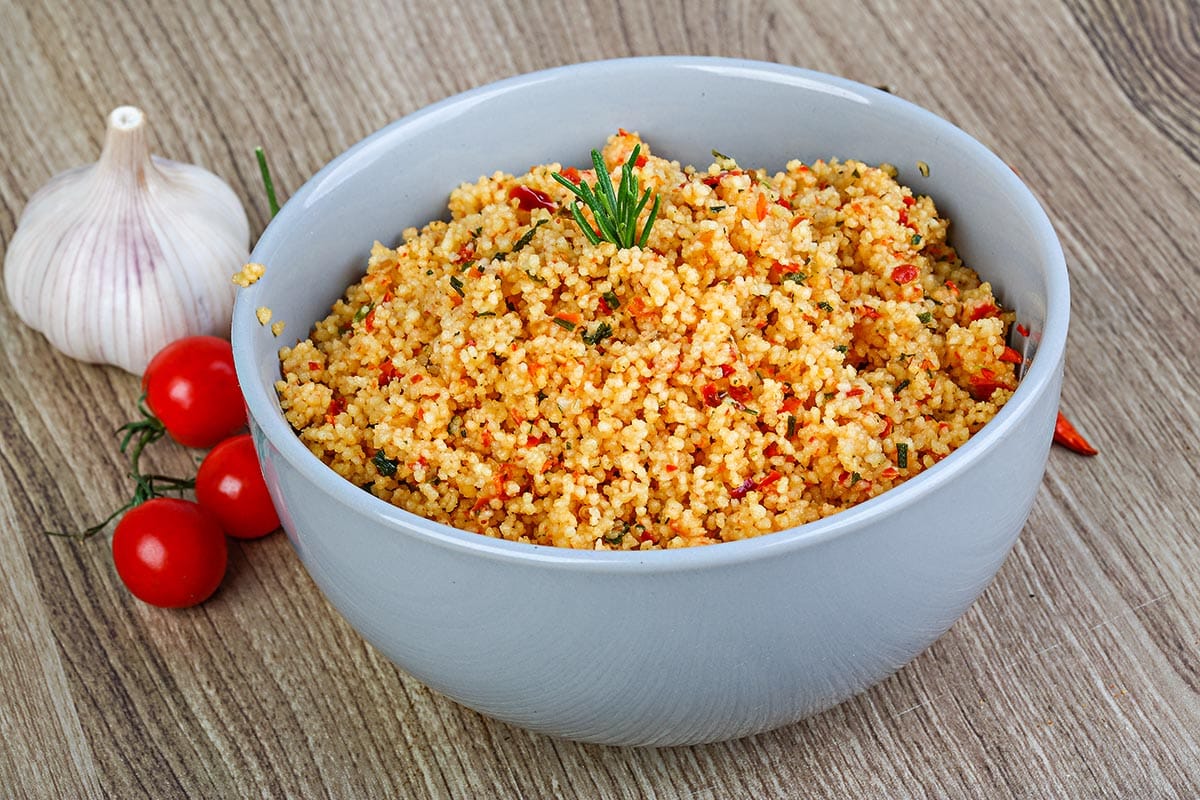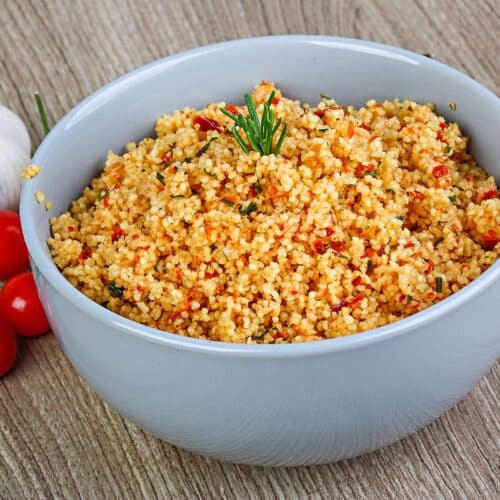Couscous is a popular North African dish that has become increasingly popular in Western countries. This light, fluffy grain-like pasta is made from semolina and can be enjoyed as part of both savory and sweet dishes. But what does couscous taste like? Read on to find out!
Does it taste like anything at all? Is it a grain, or is it pasta? In this food guide, we will answer these questions and more.

Even when it looks like grain at first glance, couscous is actually pasta. After all, it comes from semolina and wheat flour.
The origin of the word “couscous” is uncertain, but it is believed to have originated from the Berber language of North Africa. The term “couscous” translates into well-rounded, well-rolled, or well-formed.
You’ll typically find this pasta in your local grocery store’s rice or pasta section. The couscous you can buy is already pre-cooked. It is already steamed and dried, so to prepare it, you only need to rehydrate it.
Because of this, couscous is one of the fastest and easiest food items to prepare. It can be a lifesaver when you need something quick to serve your unexpected guests.
Couscous is usually a yellow-ish color and has a granular texture.
The couscous grains are small and round, resembling tiny pellets.
It’s also sometimes referred to as “Israeli style” or “giant couscous,” which refers to the larger, slightly elongated version of the grain.
Couscous is often compared to quinoa, as they look extremely identical.
The basic flavor of couscous is slightly nutty and sweet, making it a great base for both savory and sweet dishes.
It can be cooked like any other grain, such as rice or quinoa, and it pairs well with vegetables, spices, herbs, meat, fish, and dairy products.
The texture of couscous varies depending on how the grains are rolled, so it can range from soft and fluffy to firm and crunchy.
When cooked, couscous absorbs the flavors of whatever ingredients you add to it. This means that it pairs especially well with flavorful ingredients like fresh herbs, garlic, onions, tomatoes, olives, capers, feta cheese, and spices.
Given its plain taste, couscous is like a blank slate you can experiment with. You can make it sweet, savory, spicy, salty, or bitter.
The neutral flavor of couscous makes it perfect for picky eaters as well. After all, you can add and pair it with any other ingredient, and it will taste good.
There are several kinds of couscous you’ll find in the market. Here are the most popular ones:
Also called Moghrabieh, Lebanese couscous is usually larger than the other varieties. It almost looks like a chickpea due to its size. Of course, this means that Lebanese couscous takes the longest to cook.
On the other end of the couscous variations is Moroccan couscous. This type is the smallest and the most popular, so you can easily find it in stores. It only takes a few minutes to cook and is available in instant-cook versions.
Israeli couscous is also known as “pearl couscous.” this kind of couscous is the middle ground between Moroccan and Lebanese. It is larger than Morrocan but smaller than Lebanese.
This couscous comes from wheat durum flour, making it a healthier option. Whole wheat couscous offers more nutrients than regular couscous made with semolina, a processed flour.
The thing about couscous? It looks like a grain, but it is pasta. But despite being pasta, it cooks like a grain. Are you confused yet? There’s no need to be. Here’s a detailed guide to help you:
Determine how much water to boil. The amount of water depends on the kind of couscous you’re cooking. But most couscous needs a 1:1 ratio of dry couscous to water. Pour water into a saucepan and bring to a boil.
Since couscous is plain, using salt to add some taste is necessary. Put ½ teaspoon of salt for every cup of dry couscous. If you want moist couscous, you can also add some butter. Olive oil will also work for this purpose.
After seasoning the water, you can now add your couscous. Stir it to ensure it is evenly distributed in the water.
This step is what makes cooking couscous different from pasta. You don’t have to cook it in boiling water. Instead, you need to steam it. After adding couscous to boiling water, you must immediately remove the pan from the heat.
Cover the pan and steam the couscous for 10-15 minutes. Do check the package instructions for more specific cooking times.
After steaming, the couscous will clump up. Separate the pasta balls from each other with a fork. Give them a bit of a stir until they look fluffy, and that’s it. Serve your couscous!
So, did you cook couscous as directed and find it lacking? The good thing is there are ways to make it taste better.
Here are some hacks to make the best-tasting couscous:
Toasting it with some olive oil is the key to adding a layer of flavor to your couscous.
Doing this extra step might mean an extension to your cooking time. But the additional nuttiness is worth it and will definitely elevate your dish!
Instead of just owing the taste of your couscous to salt, you can use broth.
Use beef, chicken, pork, or vegetable broth to steam your couscous and enjoy a meaty flavor.
While it can be tempting to stir your couscous while steaming, you should resist.
Instead, let the couscous rest undisturbed and covered. This way, you can cook it evenly and properly.
As mentioned, the mild flavor of couscous pairs well with almost anything. That said, you can eat it with lots of other foods.
For instance, you can pair it with protein: chicken, pork, beef, and fish meats.
It tastes good when eaten with vegetables like broccoli, eggplants, tomato, garlic and squash. You can also eat it with carrots, zucchini, and peas.
Try it with a dash of lemon juice and a sprinkle of pine nuts. Or, cook it with spices such as paprika, cumin, and cinnamon.
Fresh herbs such as coriander, parsley, and basil can elevate couscous recipes.
Couscous is also so versatile that you can also have it alongside fruits. Eat couscous with blackberries, cherries, or apricots for a quick snack.

If you need more convincing to try couscous aside from its short prep time, know that it also has some health benefits.
Couscous is a nutritious and versatile food that can be eaten as part of a balanced diet. It is high in protein, carbohydrates, dietary fiber, and essential vitamins and minerals such as zinc, iron and magnesium.
One cup of cooked couscous contains 176 calories, 5 grams of protein, 37 grams of carbohydrates and 1 gram of fat.
Couscous is an excellent source of complex carbohydrates which provide long-lasting energy.
No, couscous is not gluten-free. Traditional couscous comes from durum wheat, which contains gluten. There are couscous varieties made from gluten-free ingredients.
Quinoa and couscous may look similar but do not taste the same. Couscous has a mild and neutral flavor. Quinoa, on the other hand, has nutty and earthy undertones. Compared to couscous, quinoa has a stronger flavor.
Couscous has a pasta-like texture, which is easily affected by how long you cook it. For instance, if you overcook it, the couscous will have a sticky and unpleasant texture. But, when cooked right, couscous is al dente – firm and chewy.
Yes, because couscous doesn’t have a flavor on its own, it somehow tastes like rice. It is not as bland, though, because you can taste nuttiness in couscous. Nevertheless, both these foods are versatile and can pair well with many other foods.
Couscous is pasta made from semolina flour, shaped into tiny little balls. Because of its shape and size, cooking couscous is fast and easy. That said, this pasta is a great option for making meals in a hurry.
So what does couscous taste like? Cooked couscous tastes like regular pasta, so it has a subtle nuttiness. Plain couscous gets its flavor from the ingredients you use to cook it with. For this reason, you are entirely in charge of how your couscous will taste.






